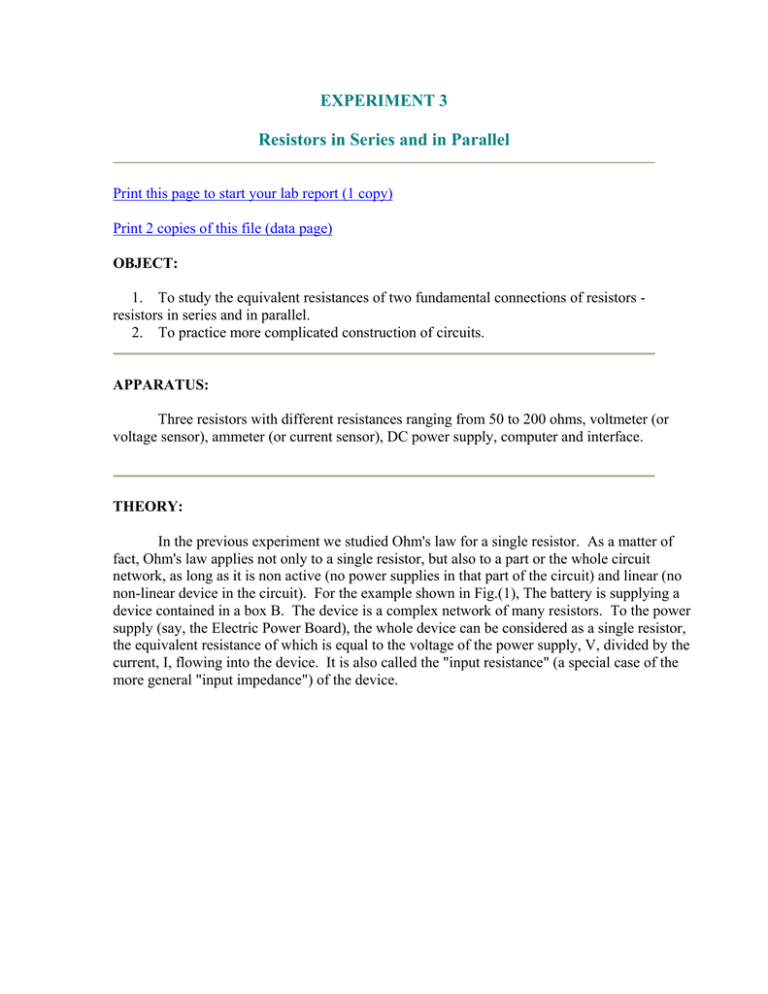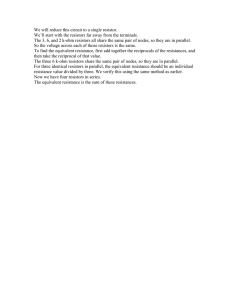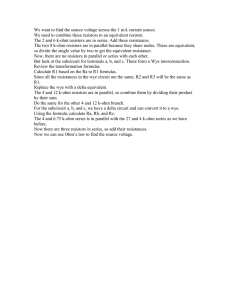EXPERIMENT 3 Resistors in Series and in Parallel
advertisement

EXPERIMENT 3 Resistors in Series and in Parallel Print this page to start your lab report (1 copy) Print 2 copies of this file (data page) OBJECT: 1. To study the equivalent resistances of two fundamental connections of resistors resistors in series and in parallel. 2. To practice more complicated construction of circuits. APPARATUS: Three resistors with different resistances ranging from 50 to 200 ohms, voltmeter (or voltage sensor), ammeter (or current sensor), DC power supply, computer and interface. THEORY: In the previous experiment we studied Ohm's law for a single resistor. As a matter of fact, Ohm's law applies not only to a single resistor, but also to a part or the whole circuit network, as long as it is non active (no power supplies in that part of the circuit) and linear (no non-linear device in the circuit). For the example shown in Fig.(1), The battery is supplying a device contained in a box B. The device is a complex network of many resistors. To the power supply (say, the Electric Power Board), the whole device can be considered as a single resistor, the equivalent resistance of which is equal to the voltage of the power supply, V, divided by the current, I, flowing into the device. It is also called the "input resistance" (a special case of the more general "input impedance") of the device. Figure 1 The equivalent resistance depends of the construction of the device, and can be calculated from the individual resistances if the construction is known. In this experiment, we will study the two simplest combinations: resistors in series and in parallel. If two resistors R1 and R2 are connected in series, the currents passing through the two resistors are equal, and the total voltage is equal to the sum of the individual voltages across the two resistors (Fig. 2): V = V1 + V2. Figure 2 Applying Ohm's law for all terms in the above equation, we have: R2 . Since I = I1 = I2 , we obtain R = R1 + R2 (1) I R = I1 R1 + I2 Equation (1) says that the equivalent resistance of the resistors connected in series is equal to the sum of the individual resistances. It is not hard to see that this rule applies to any number of resistors connected in series. On the other hand, if two resistors R1 and R2 are connected in parallel, the voltages across the two resistors are equal, and the total current is equal to the sum of the individual currents passing through the two resistors (Fig. 3): I = I1 + I2 . Figure 3 Again applying Ohm's law to the terms in the above equation, we have V/R =V1/R1 +V2/R2 Since V = V1 = V2 , we obtain the relationship between the equivalent total resistance R and the individual resistances R1 and R2 : 1/R = 1/R1 +1/R2 (2) Likewise, the above relationship applies to any number of resistors connected in parallel. Equations (1) and (2) can be used to find the equivalent resistance of more complex networks such as the ones shown in figures (4) and (5). It is left to the students to figure out the ways to do it in the following procedure. Figure 4 Figure 5 Procedure 1. Turn on the computer and interface. Use the voltage sensor and the current sensor to measure the voltages and currents. Get to the appropriate program to run this experiment with the help of your instructor. Use the method learned from the previous experiment to measure the resistances of the three resistors R1, R2 and R3. You do not have to make a hard copy of the plot, but do use the linear fitting program to obtain the resistances. Record these values and their errors in your data table. 2. Construct a circuit in series like Figure 2, but with three resistors in series instead of two. Run the program again to obtain the total resistance of the three resistors in series. Record the value and the error in your data table. 3. Construct a circuit in parallel like Figure 3 with three resistors. Repeat the procedure stated in step 2 to find the experimental equivalent resistances. 4. Construct a mixed circuit of Figure 4. Repeat the measurement described above. 5. Construct a mixed circuit of Figure 5 and repeat the measurement. DATA ANALYSIS: 1. For the circuit in series (Figure 2) derive the formula and calculate the theoretical total resistance by making use of Eq. (1) and the individual resistances obtained in step 1 of the procedure. Show all your calculations. Calculate the difference between the theoretical and the experimental values. Find the percentage error. 2. For the circuit in parallel (Figure 3) derive the formula and calculate the theoretical total resistance by making use of Eq. (2) and the individual resistances obtained in step 1 of the procedure. Show all your calculations. Calculate the difference between the theoretical and the experimental values. Find the percentage error. 3. For the mixed circuits in series (Figure 4 and 5) derive the formula and calculate the theoretical total resistance using the individual resistances obtained in step 1 of the procedure. Show all your calculations. Calculate the difference between the theoretical and the experimental values. Find the percentage error. Reminder: Check you math, check the units, check the rounding, do not forget to follow the format for your lab report (see syllabus).







